#angels & insects 1995
Explore tagged Tumblr posts
Text








patsy kensit in angels and insects (1995) dir. philip haas
19 notes
·
View notes
Text
Movies/TV Watched 2024
Asteroid City (Wes Anderson, 2023)
Nomadland (Chloé Zhao, 2020)
Cordelia (Adrian Shergold, 2019)
The Piano (Jane Campion, 1993)*
Malcolm X (Spike Lee, 1992)*
Avatar (James Cameron, 2009)
Child’s Play (Tom Holland, 1988)*
Train (Gideon Raff, 2008)
Silent Hill (Christophe Gans, 2006)
Nam June Paik: Moon Is the Oldest TV (PBS American Masters) (Amanda Kim, 2023)
Past Lives (Celine Song, 2023)
Basic Instinct [Director’s Cut] (Paul Verhoeven, 1992)*
In Cold Blood (Richard Brooks, 1967)
What Lies Beneath (Robert Zemeckis, 2000)
Fellini Satyricon (Federico Fellini, 1969)
Significant Other (Dan Berk, Robert Olsen; 2022)
The Mimic (Huh Jung, 2017)
Extinction (Miguel Ángel Vivas, 2015)
The Visit (M. Night Shyamalan, 2015)
The Hole in the Ground (Lee Cronin, 2019)
Batman (Tim Burton, 1989)
Cronos (Guillermo del Toro, 1993)
Under the Skin (Jonathan Glazer, 2013)
Our Flag Means Death [szn 2] (2023)
Wes Craven Presents: They (Robert Harmon, 2002)
Carnival of Souls (Herk Harvey, 1962)
Leviathan (George P. Cosmatos, 1989)
Rick and Morty [szn 5] (2021)
Dark Skies (Scott Stewart, 2013)
Insidious: Chapter 2 (James Wan, 2013)*?
Insidious: Chapter 3 (Leigh Whannell, 2015)
Insidious: The Last Key (Adam Robitel, 2018)
Insidious: The Red Door (Patrick Wilson, 2023)
American Graffiti (George Lucas, 1973)*?
The Pope’s Exorcist (Julius Avery, 2023)
Independence Day (Roland Emmerich, 1996)*
Men in Black (Barry Sonnenfeld, 1997)*
The Exorcist (William Friedkin, 1973)*
Poor Things (Yorgos Lanthimos, 2023)
Angels & Insects (Philip Haas, 1995)*?
Tucker & Dale vs. Evil (Eli Craig, 2010)
The Purge (James DeMonaco, 2013)
4/20 Massacre (Dylan Reynolds, 2018)
The Fast and the Furious (Rob Cohen, 2001)
Poisoned Ground: The Tragedy at Love Canal (PBS American Experience) (Jamila Ephron, 2024)
Beetlejuice (Tim Burton, 1988)*
The Signal (William Eubank, 2014)
Beetlejuice Beetlejuice (Tim Burton, 2024)
The SpongeBob SquarePants Movie (Stephen Hillenburg, Mark Osborne; 2004)
Felix the Cat: The Movie (Tibor Hernádi, 1988)
Speak No Evil (James Watkins, 2024)
Kwaidan (Masaki Kobayashi, 1964)*?
The Portrait of a Lady (Jane Campion, 1996)
Sisters with Transistors (Lisa Rovner, 2020)
Holy Smoke! (Jane Campion, 1999)
Shock Treatment (Jim Sharman, 1981)*
Space: The Longest Goodbye (Ido Mizrahy, 2023)
House of Wax (Jaume Collet-Serra, 2005)
The Lion, the Witch and the Wardrobe (Bill Melendez, 1979)*
Wojnarowicz: F**k You F*ggot F**ker (Chris McKim, 2020)
Longlegs (Osgood Perkins, 2024)
O Brother, Where Art Thou? (Joel Coen, 2000)*
Tess (Roman Polanski, 1979)
Barbarian (Zach Cregger, 2022)
Home Alone (Chris Columbus, 1990)*
Jennifer’s Body (Karyn Kusama, 2009)
Rick and Morty [szn 6] (2022)
The Seeding (Barnaby Clay, 2024)
Edward Scissorhands (Tim Burton, 1990)*
Beatles ’64 (David Tedeschi, 2024)
Fanatical: The Catfishing of Tegan and Sara (Erin Lee Carr, 2024)
Raggedy Ann & Andy: A Musical Adventure (Richard Williams, 1977)*
Rick and Morty [szn 7] (2023)
Five Nights at Freddy’s (Emma Tammi, 2023)
Immaculate (Michael Mohan, 2024)
Freaknik: The Wildest Party Never Told (P. Frank Williams, 2024)
The Booksellers (D. W. Young, 2019)*
His House (Remi Weekes, 2020)
Time Cut (Hannah MacPherson, 2024)
Don’t Move (Adam Schindler, Brian Netto; 2024)
Carry-On (Jaume Collet-Serra, 2024)
Subservience (S. K. Dale, 2024)
The Muppet Christmas Carol (Brian Henson, 1992)*
May December (Todd Haynes, 2023)
Horse Girl (Jeff Baena, 2020)
Psycho (Alfred Hitchcock, 1960)*
Movies/TV watched 2024; asterisks * are rewatches, asterisks w/question marks *? are rewatches I couldn’t remember having seen before but had a vague sense of familiarity and/or I found evidence of watching elsewhere in my archive. Struck titles were unfinished (I absolutely loved the book In Cold Blood but dozed off a bunch during the movie; Under the Skin seemed promising but I had to turn it off because I could NOT emotionally deal with the baby on the beach.)
This year I treated myself to some old weird nostalgia movies on VHS (YouTube or Internet Archive links provided when available). We have a decent collection of thrifted DVDs and we borrow a lot of movies from the library. Occasionally I’ll sign up for a month of a streaming service if there’s something ~exclusive~ we want to watch, and then we’ll end up watching whatever horror garbage is offered. Honestly, I think “meh, it was okay” was my main reaction to a lot of the movies I watched this year? Kind of a bummer.
Favorites in 2024: BEETLEJUICE BEETLEJUICE!!!!! I just loved everything about it :D I thought it was aesthetically the right amount of Tim Burton without being *too much* Tim Burton, ya know? (Love movie environments that feel like a dark ride!) Beetlejuice is a forever favorite, one of my earliest “crushes” (proving that I have absolutely never had good taste in men & that as early as age 4 I yearned for a witty dirtbag prankster to show up and “promptly whisk [me] off from [my] ordinary life into wacky adventures in the land of the dead” [description from the box set of the animated series, yikes lmao; my other fave beginning around this time was Doctor Who lol, obvious underlying theme is obvious]). ANYway, BJ BJ was also the first movie we saw in theatres post-covid! Not necessarily due to covid-related concerns, but just like, idk, being busy and frugal homebodies. And I guess since more theatres are offering restaurant food nowadays, they’re making it more difficult to sneak food in (no bags allowed), booooo.
Other faves: Asteroid City (I’m not usually a Wes Anderson person but this was visually stunning), His House, Poor Things. The Seeding was pretty wild, if heavy-handed. Tho I kind of thought *everything* about male/female relationships in horror movies I saw this year was getting pretty heavy-handed :/ Sisters with Transistors was a cool documentary about women (Delia Derbyshire, Daphne Oram, Wendy Carlos, Pauline Oliveros, et al.) in the early days of electronic music, dreamily narrated by Laurie Anderson (*heart-eyes*). Beatles ’64 was surprisingly okay! I *really* appreciated the interviews with people who were young Beatlemaniacs back in the ‘60s, hearing (mostly) women talk about how the Beatles represented a new way of being masculine, how liking the Beatles could provide a sense of agency for women navigating their own desires, etc. That was a cool perspective which I do not personally encounter very often in the Beatles cinematic universe. (For background: My two most recent long-term relationships have been with indie musicians who just happen to be extremely obsessed with the Beatles, so I’ve spent the past 17+ years absorbing deep dives about how great they are, and while I like many of their songs and Understand Their Position of Importance in the History of Pop/Rock/Human Culture, I just do not give a fuuuck on a personal level. But I do still begrudgingly respect my partner’s interest enough to occasionally watch a Beatles documentary with him.)
5 notes
·
View notes
Text
Was Doug TenNapel's Gear inspired by Evangelion?
DISCLAIMER: This will probably contain spoilers for both of the above-mentioned series.
A while back, I read Doug TenNapel's Graphic Novel "Gear," his first big comic story that started his career as a "comic-er" as he once put it.
Gear tells the story of four cats in a world at war with cats, dogs, and insects. All of which have access to giant robots called "Guardians" and the fabled "forbidden mechanism" that has the power to turn the tables for whoever uses it.
It's an interesting story, one with some aspects that feel strangely familiar. More specifically, it made me think of a certain 90s mech anime... Neon Genesis Evangelion.
Now, before I say anything else, let me just say that I don't know if Doug TenNapel ever watched NGE or not, but there are at least a few similarities that seem almost too close to be a coincidence, which I'm going to point out here.
1. Timing.
According to Doug in the bonus material section of Gear's 20th anniversary edition release, He started writing Gear in 1997, the first issue of Gear was published by Fireman press on November 1998 and the last issue came out in April 1999.
NGE Started airring in Japan in 1995 with the last episode airring on March 27, 1996.
AD Vision A.K.A. ADV Films Dubbed the series in English in 1996 to 1998.
This means Doug TenNapel could've seen the show prior to or maybe even during writing Gear.
2. Weapons of War.
In NGE, the Eva pilots mainly have two weapons at their disposal, guns, and a plasma powered knife called the "Progressive Knife" or "Prog Knife."
In Gear, they are quite a few guns. including ones built into at least some of the guardians, and while there aren't any plasma powered knives that resemble giant carpet knives, We do see Gordon, one of the main four cats carry around a knife that becomes an important part of the story towards the end, however in the original Fireman press version of the comic, we see him use his knife to take out a few unsuspecting dog troops during the blood rage scene. also, while the guns shoot lasers in the 20th anniversary edition, in the original they fire bullets.
3. Angels of Lore.
In NGE, The world is under attack by giant powerful mysterious creatures referred to as "Angels."
Gear doesn't have such beings in its story however, the title character, a somewhat bumbling robot at one point refers to Heaven as "his home" which sounds odd until you look at the temple catacombs, which contain a hieroglyphic depicting the origins of the forbidden mechanism, revealing that it was forged from the remains of an angel that fell to earth after being defeated by a demon.
This implies that Gear isn't just a robot, but a robot with the soul of an angel.
4. Familiar Smells.
At one point in NGE, the main character, Shinji, notices that the smell of Eva Unit 01's cockpit reminds him of his mother.
In Gear, after Waffle undergoes "Geno Mutation" and turns into a guardian, Gordon notes that the guardian is not only the same color as Waffle but also smells like him.
5. Soul in the Shell.
Near the end of NGE, It's revealed (kind of) that Units 01 and 02 absorbed the souls of Shinji's mother and Asuka's mother, and their souls reside inside their Evas.
In Gear, during what seems like a miracle, Gear uses his power to the souls of Waffle and an insect named Chee into their guardian bodies to aid in the final battle.
6. The Mastermind.
In NGE, Shinji's father Gendo has an ulterior motive of bringing about the "The Human Instrumentality Project" in an attempt to reunite with his deceased wife Yui.
In Gear, Emperor Pago wants the forbidden mechanism to power up his guardian and conquer the world.
7. Blood in the Machine.
In NGE, The Evas are humanoid and are able to bleed.
In Gear, we see Waffle's bleed as he is crushed by Pago's guardian,
and we see Pago's guardian also bleed when Gear stabs himself to stop him.
8. Finding God.
NGE has many references to the Bible, Christianity, and Catholicism. From the aforementioned angles to the names of said angels (that apparently aren't mentioned in the actual show for some reason), to symbolic crosses seen throughout the series.
Gear is a bit more subtle with it's references to Christianity and the Bible, namely a panel consisting of the character Simon giving an account of Heaven, the implication of Gear having the soul of an angel as mentioned earlier, and Pago quoting Goliath during the final battle.
One thing I will point out is that technically Doug first started referencing Christianity in his work with The Neverhood, a PC point-and-click adventure game that released (ironically) in 1996.
If Doug did see Evangelion, maybe it inspired him to reference his faith in his stories. After all, if a weird Japanese mech anime could do it, why couldn't he?
That's all the similarities I noticed. Was Doug inspired by Evangelion? I don't know, but it's interesting to think about.
2 notes
·
View notes
Text
Angel In The Mirror
The Angel in the Mirror™ was marketed during the 1995 holiday season as a means of communing with a deity without the inconveniences of a complex faith. For the low price of 59.99, you would have unfettered divining rights to discern even the most mysterious of life's questions. For a ritual object, it was a fairly simple set-up compared to what could be found in the ostentatious halls of the Oblationist. Gone were the days of making the trip out to receive banal gifts and visions from the various registered gods. This was the modern family's solution to keep up with work-worship balance. All that production needed was a single pane of two-way glass, backlit by a bulb no brighter than what you'd find in a nightlight. With a flick of a switch you would blur the other side of the mirror and await her visage to find its way to you. The shadow of a resplendent being, wings outstretched and welcoming you into her presence. A handy guide of hymns and prayer was included free with every purchase. All the praise and thanks she would ever need. "From afar, we watch the world. From within, we watch ourselves. You are the sight beyond sight. Grace us so we may one day see."
Of course, making a god was the big strategic cost. The company thought we'd be a little clever and repurpose a minor one that the courts had deemed too unwieldly for the general public. The freaky backwoods types that you see on the news every now and again. Something with all the work already put into it.
The Damselfly. She Who Bears Witness. Initially we were afraid of what the focus groups would think of some great insect, but the aspects that had been used to create her fit what we had been looking for. Soothsaying, guardian of oracles and the lost, and most importantly, omen of good fortune to a newly built household. She agreed to our rebranding ideas after we had explained how useful she would be again. Pterostigma was traded in for feathers. When she hit the market, we had thought we had hit gold. Initial sales sold like hot cakes, and the reviews coming in had branded the Angel in the Mirror™️ as the fad of the year. We were finding that while families were still our main buyer, there was a smaller but growing demand for her from the 20-25 age demographic. Young adults still in college or entering the workforce, still full of anxiety for the future. "What if I don't pass my classes?" "Is this job what I want to do for the rest of my life?" "How am I going to pay back these loans?"
The more contemporary gods wouldn't have responded to such trivial questions, but the Angel in the Mirror™️ was more than happy to assuage their fears and listen. A gentle voice to give insight into each and every possibility. Her guiding hand reaching out to help walk you through even the most minute detail in some cases. We should have realized what had gone wrong then and there, but we were too blind to the truth of what we had done. May 12th, 1996 was the official start of the recall. We had been destroying the units we had in our facilities months before that however. The first case of a breach had occurred during our preparations for the next holiday season. Some kid down south, without a lick of sense in him, had fashioned her a way through. The divine made flesh is never a pretty sight, but this aspect of her that was able to materialize was definitely not the smiling woman we had plastered in our ads.
Our mistake was not researching what the Damselfly did to her adherents beyond the beneficial. She was a crepuscular predator, who would devour those caught without the options that a future would provide. When she could no longer see the paths ahead for you, she would convince you that there was only one real choice left. Better to be one with her forever than to face a sorrowful tomorrow. We had given her unfettered access beyond the small base that had spawned her. And as report after report started to come through soon after, we knew she was taking advantage of that. Those lucky enough to listen to her during the day found that the sun was too bright for her many eyes, just a moment or two more to decide against her calling. Others were gone the moment she reached through for them.
The officers of The Wasting Maw were able to contain her influence after a short stand-off, but the damage to our brand had been done. We paid our dues in refunds and the usual mandated fines with these sorts of things. Our then CEO even had to address the public, sweating bullets as he apologized for the oversight in our product design, promising that our newest line wouldn't lead to mass disappearences. You still see cultists buying up mirrors online, those who wished to have been called by her or maybe don't understand what it meant. They pay thousands of dollars to adorn themselves in the shards of what they get their hands on, becoming her eyes out to the world. They pray that she will darken the panes once more and whisper of tomorrow.
7 notes
·
View notes
Text
Post War Anime and the effects on Japanese culture.
It’s well known that Japanese animation starts way back in the 1900s but it’s after World War II that we see a drastic change in the ways of their storytelling.
Japan had witnessed firsthand the horrifying power of the American nuclear weapons, and the atomic blast left scars physically and mentally on Japanese society.
Following the war, American censorship practically forbade the Japanese from reporting or featuring it in fiction and nonfiction, but when the occupation period was over and inspired directly by the release of the American film King Kong (1933), Japan produced their very own monster movie, Godzilla (1954), being the first films that talked about what happened at the end of WWII. Producer Tomoyuki Tanaka said, "The theme of the film, from the beginning, was the terror of the bomb. Mankind had created the bomb, and now nature was going to take revenge on mankind."
Anime on the other hand was a little slower in addressing those themes.
Post war period soared Japan in ruins and as a facto colony of the United States left, Japan after 18 years was rebuilt regained their independence and their economy was stronger than ever, making Japanese society totally changed with their culture and technology unifying the nation, witnessing the creation of one of the most important animation at the time, Astro Boy (1962) making the show a surprise hit, starting an anime boom and a period of intense competition for TV audiences. The success marked the beginning of a new kind of anime industry.
Some very well-known animes that depicts these themes are:
Nausicaa of the Valley of the Wind (1984), directed by Hayao Miyazaki. Set one thousand years from now, the Earth is ravaged by pollution and war. In the Valley of the Wind lives Nausicaä, Princess of her people. Their land borders on a toxic jungle, filled with dangerous over-sized insects. Meanwhile, two nearby nations are bitterly engaged in a war and the Valley of the Wind is stuck in the middle. It’s important to mention for this film the animator once again created a scene featuring a mushroom cloud, when the giant monster fires its energy beam.

Akira (1988), based on the manga of the same name. The film opens with an explosion of indeterminate origin that wipes Tokyo from the face of the Earth and triggers World War III. In a 2019 Tokyo (now 'Neo-Tokyo') has been rebuilt and is a thriving metropolis. Shotaro Kaneda is the leader of a biker gang, his friend Tetsuo is injured in an accident and taken to a top-secret government facility. He develops telekinetic powers but decides to use them for evil rather than good. He has the same powers as Akira, the force that destroyed Tokyo in 1988, and now it appears that history will repeat itself.

At first glance, Ghost in the Shell (1995) seems to center on the activities of cyborg special agents (some of whom have participated in various military conflicts). In the year 2029 the world has become intensively information oriented, and humans are well-connected to the network. Crime has developed into a sophisticated stage by hacking into the interactive network. To prevent this, Section 9 is formed. These are cyborgs with incredible strengths and abilities that can access any network on Earth.

And Evangelion (1995) In the year 2015, fifteen years after the first and disastrous contact with mysterious beings known as Angels, which resulted in a worldwide cataclysm called Second Impact, which brought the planet to the brink of doom and the entire population was reduced in half. To prevent future angel attacks, the NERV organization in Tokyo-3, developed a series of biomechanical giants called Evangelion. Then it comes to light that the impact was caused due to behind-the-scenes schemes and plots intertwined by the powerful of the world.

Therefore, we can say that these animations, thanks to their storytelling, tell us part of the history of Japan and how Japanese society was able to overcome their traumas through Anime, becoming a form of expression and liberation for the latest Japanese generations.
- Catalina Y. B ✮
4 notes
·
View notes
Text





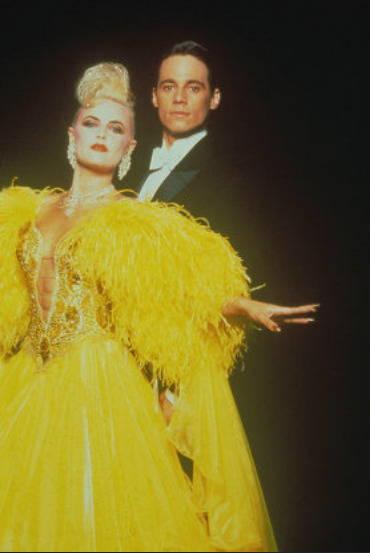




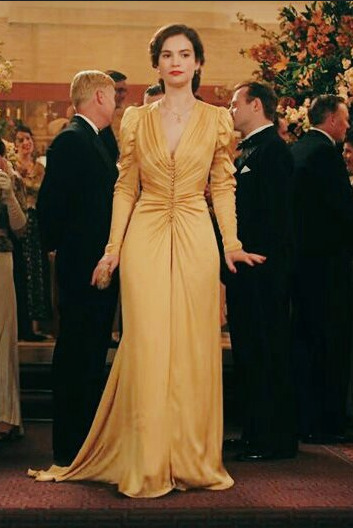
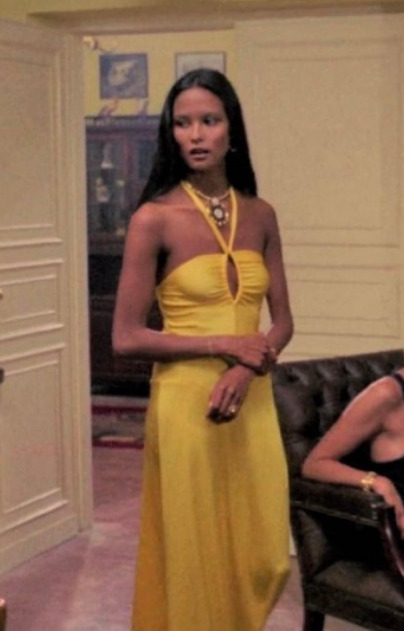
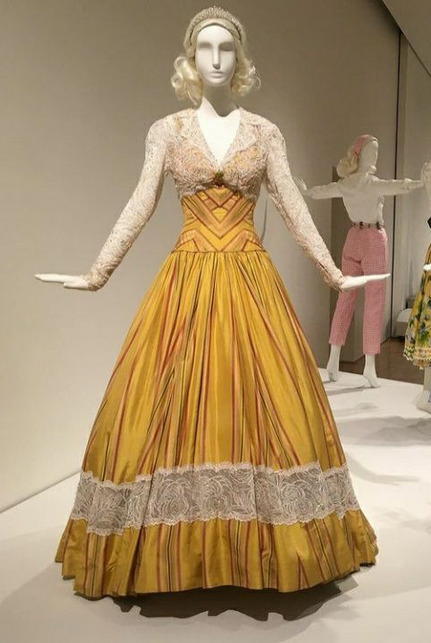
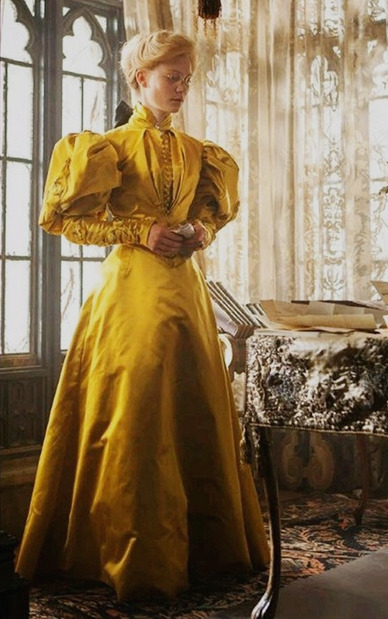

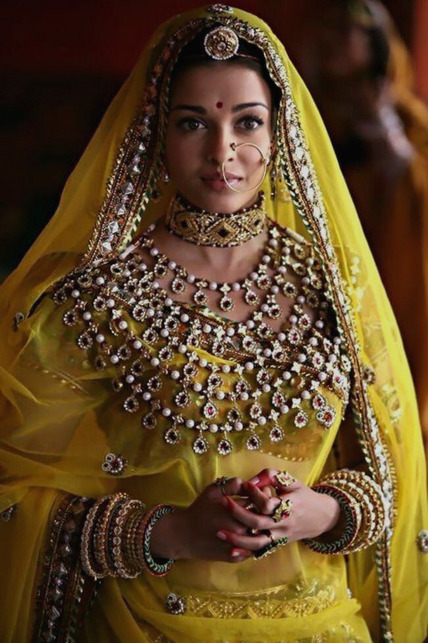
Top 16 Favorite Film Gowns
Yellow
~~ The Love Witch (2016) ~~ The Legend of Zorro (2005) ~~ Dr. Dolittle (1967) ~~ Elizabeth: The Golden Age (2007) ~~ Mirror Mirror (2012) ~~ Strictly Ballroom (1992) ~~ Gypsy (1962) ~~ Angels & Insects (1995) ~~ The Virgin Queen (1955) ~~ Til the Clouds Roll By (1946) ~~ The Guernsey Literary and Potato Peel Pie Society (2018) ~~ Emanuelle in America (1977) ~~ The Stepford Wives (2004) ~~ Crimson Peak (2015) ~~ Casino (1995) ~~ Jodhaa Akbar (2008) ~~
3 notes
·
View notes
Photo






Angels and Insects Philip Haas. 1995
Alabaster Estate Arbury Hall, Arbury Park, Nuneaton CV10 7NF, UK See in map
See in imdb
#philip haas#angels and insect#mark rylance#kristin scott thomas#patsy kensit#arbury hall#arbury park#nuneaton#united kingdom#uk#england#movie#cinema#film#location#google maps#street view#1995#google earth
23 notes
·
View notes
Text
“ANGELS & INSECTS” (1995) Review

“ANGELS & INSECTS” (1995) Review
I never thought I would come around to writing this review. I have seen the 1995 movie, “ANGELS & INSECTS” a good number of times during the past five years. Yet, I never got around to posting a review of this movie, until recently. Why? I have not the foggiest idea. Nor do I have any idea why I had finally decided to write that review.
Based upon A.S. Byatt’s 1992 novella called “Morpho Eugenia”, “ANGELS & INSECTS”tells the story of a poor naturalist named William Adamson, who returns home to Victorian England after having spent years studying the natural wildlife – especially insects – in the Amazon Basin. Despite losing all of his possession during a shipwreck, he manages to befriend a baronet named Sir Harald Alabaster, who is also an amateur insect collector and botanist. The latter hires William to catalog his specimen collection and assist his younger children’s governess the natural sciences.
William eventually falls for Sir Harald’s oldest daughter, Eugenia, who is mourning the suicide of her fiance. Both of them eventually become emotionally involved and decide to marry. Much to William’s surprise, both Sir Harald and Lady Alabaster seems encouraging of the match. The only member of the Alabaster family who is against their upcoming wedding is Sir Harald’s eldest child, the arrogant Edgar. Not only is the latter close to Eugenia, he believes that William is unworthy of his sister’s hand, due to having a working-class background. The marriage between William and Eugenia seemed to be a happily lustful one that produces five children (among them two sets of twins). But Eugenia’s hot and cold control over their sex life, a constantly hostile Edgar, William’s growing friendship to Lady Alabaster’s companion Matilda “Matty” Crompton, and William’s own disenchantment over his role as Sir Harald’s official assistant brings their marriage to a head after several years of marriage.
The film adaptation of Byatt’s novella seemed to be the brainchild of Philip and Belinda Haas. Both worked on the film’s screenplay, while Philip also served as the film’s director and Belinda served as both co-producer (there are three others) and film editor. From my perusal of many period drama blogs, I get the feeling that “ANGELS & INSECTS” is not very popular with many of the genre’s fans. On the other hand, many literary and film critics seemed to have a very high regard for it. Despite my love for the usual romantic costume drama, I must admit that my opinions of the 1995 film falls with the latter group. It is simply too well made and too fascinating for me to overlook.
There were times I could not tell whether “ANGELS & INSECTS” is some look at the age of Victorian science exploration, the close study of an upper-class 19th century family, or a lurid tale morality. Now that I realize it, the movie is probably an amalgamation of them all, wrapped around this view on Darwinism and breeding – in regard to both the insect world and humans. The topic of breeding seemed to seep into the screenplay in many scenes. Some of them come to mind – Sir Harald and Edgar’s debate on the breeding of horses and other animals, William and Eugenia’s second encounter with moths in the manor’s conservatory, Sir Harald’s despairing rant on his declining usefulness within his own household, the reason behind Edgar’s hostility toward William, and the visual comparisons between the bees and the inhabitants of the Alabaster estate, with Lady Alabaster serving as some metaphor for an aging Queen bee on her last legs. The metaphor of the Queen bee is extended further into Eugenia. Not only does she assume her mother’s role as mistress of the house following the latter’s death; but like Lady Alabaster before her, gives birth to a growing number of blond-haired children. If a person has never seen “ANGELS AND INSECTS” before, he or she could follow both the script and cinematographer Bernard Zitzerman’s shots carefully to detect the clues that hint the cloistered degeneracy that seemed to unconsciously permeate the Alabaster household.
I cannot deny that “ANGELS & INSECTS” is a gorgeous film to behold. Philip and Belinda Haas, along with the film’s other producers did an excellent job in creating a visually stunning film with a bold and colorful look. Cinematographer Bernard Zitzermann, along with production designer Jennifer Kernke and Alison Riva’s art direction provided great contributions to the film’s visual style. But in my opinion, Paul Brown’s Academy Award nominated costume designs not only conveyed the film’s colorful visual style more than anything else, but also properly reflected the fashion styles of the early 1860s for women – including the growing penchant for deep, solid colors – as shown below:


Adding to the movie’s rich atmosphere was Alexander Balanescu’s memorable score. I thought the composer did an excellent job of reflecting both the movie’s elegant setting and its passionate, yet lurid story.
As much as I enjoyed and admired “ANGELS & INSECTS”, I believe it had its flaws. I understand why Philip Haas had opened the movie with shots of William Adamson socializing with inhabitants of the Amazonian jungle, juxtaposing with the Alabaster ball given in his honor. Is it just me or did Haas use white – probably British – actors to portray Amazonian natives? I hope I am wrong, but I fear otherwise. I also feel that the movie was marred by a slow pacing that nearly crawled to a halt. I cannot help but wonder if Haas felt insecure by the project he and his wife had embarked upon, considering that “ANGELS & INSECTS” was his second motion picture after many years as a documentarian. Or perhaps he got caught up in his own roots as a documentarian, due to his heavy emphasis on the natural world being studied by William, Matty and the younger Alabaster children. In a way, I have to thank Balanescu’s score for keeping me awake during those scenes that seemed to drag.
I cannot deny that the movie featured some top-notch and subtle performances. Mark Rylance, who has a sterling reputation as a stage actor, gave such a quiet and superb performance that his reputation has extended to film, resulting in a Best Actor Oscar over a year ago. Kristin Scott-Thomas was equally superb as the Matty Crompton, Lady Alabaster’s very observant companion, who shared William’s interests in natural sciences. I have no idea what reputation Patsy Kensit has as an actress, but I certainly believe she gave an excellent performance as William’s beautiful and aristocratic wife, Eugenia Alabaster, whose hot and cold attitude toward her husband kept him puzzled. Jeremy Kemp gave one of his more complex and entertaining performances as William’s father-in-law, the amateur scientist Sir Harald Alabaster. Douglas Henshall had a difficult job in portraying the bullying Edgar Alabaster, who seemed to view William as both beneath contempt and something of a threat to his views of the world. The movie also featured solid performances from the likes of Anna Massey, Saskia Wickham, Chris Larkin, Clare Redman and Annette Badlands.
Some fans of period drama might be taken aback by the graphic sexuality featured in the film, along with the story’s lurid topic. And director Philip Haas’ pacing might be a bit hard to accept. But I feel that enduring all of this might be worth the trouble. Philip and Belinda Haas, along with the crew and a cast led by Mark Rylance, Kristin Scott-Thomas and Patsy Kensit did an excellent in re-creating A.S. Byatt’s tale on the screen, and creating a first-rate movie in the end.
#angels & insects#a.s. byatt#philip haas#belinda haas#angels & insects 1995#mark rylance#kristin scott thomas#patsy kensit#douglas henshall#chris larkin#saskia wickham#clare redman#anna massey#annette badlands#jeremy kemp#victorian age
4 notes
·
View notes
Text
Switchblade Symphony Discography
I think it's no secret by now that I fucking love the band Switchblade Symphony based on how much I post about them. What can I say? They're one of my all-time favorite bands!
I know it's probably getting real annoying just how much I post about Switchblade Symphony, but I want to post as much as I can about them because the world needs to know how criminally underrated this band and their music is, and how talented Susan and Tina were. Tina Root is one of my favorite female singers, and Susan Wallace is one of my favorite musicians. Together they were an unstoppable duo, and it's such a shame that the band broke up after releasing only three albums.
With that said, the band also released a few EPs and Singles—as well as some other albums released by their record label after they broke up—that are part of their discography, and I want to share them, in order, of course.
So here it is, the Switchblade Symphony discography. Enjoy! 🖤
• - • - • - • - • - • - • - • - • - • - • - • - • - • - • - •
Fable EP | 1992
Gutter Glitter
Bad Trash
Chain
Mine Eyes
Rain
Bloody Knuckles
Elegy EP | 1993
Clown
Dollhouse
Numb
Ride
Serpentine Gallery | 1995
Bad Trash
Dissolve
Wallflower
Wrecking Yard
Clown
Cocoon
Dollhouse
Sweet
Gutter Glitter
Mine Eyes
Bloody Knuckles
Clown | 1996
Clown
Clown (Leather Strip Remix)
Nightshift
Sleep (Effcee Remix)
Drool | 1997
Drool (Mother)
Clown (Transmuator vs Raz)
Soldiers
Scrapbook | 1997
Chain
Rain
Dissolve (Keith Hillenbrandt Mix)
Dollhouse (Damned Mix)
Numb
Ride
Dollhouse (Live at Slim's in San Francisco)
Live 105 Radio Interview
Bread and Jam for Frances | 1997
Witches
Dirty Dog
Roller Coaster
Situation #58
Soldiers
Sleep
Funnel
Insect
Rampid
Situation #9
Sheep
Fractal
Sick Mary
Episode G15
The Three Calamities | 1999
Invisible
Wicked
Naked Birthday
Invitation
Fear
Monsters
Therapy
Copycat
Green
Into The Sky
Anmorata
Sinister Nostalgia | 2001
Sweet (Apoptygma Berzerk Mix)
Dollhouse (Razed In Black Mix)
Dissolve (Kevin Haskins of Bauhaus Mix)
Cocoon (Meegs Mix)
Clown (Mother's Mix)
Insect (6AM Eternal Mix)
Dissolve (Keith Hillenbrandt Mix)
Invisible (Endanger Mix)
Rampid (Shining Mix)
Witches (Temple Of Rain Mix)
Naked Birthday (Gothtastic Mix)
Cocoon (Rosetta Stone Mix)
Dirty Dog (Enrapture Mix)
Wicked (Susan Wallace Mix)
Sweet, Little Witches | 2003
Witches
Dollhouse
Rampid
Novocaine
Funnel
Roller Coaster
Into The Sky
Invisible
Wicked
Wrecking Yard
Dirty Dog
Dissolve
Soldiers
Clown
Serpentine Gallery Deluxe Edition | 2005
Deluxe Tracks:
Waiting Room
Chain
Rain
Numb
Ride
Novocaine
Wrecking Yard (live)
Sweet (Burning Mix)
Blue
Live 105 Radio Interview
Live in Los Angeles | 2019
Drool (live)
Wicked (live)
Rampid (live)
Gutter Glitter (live)
Dirty Dog (live)
Dissolve (live)
Soldiers (live)
4 notes
·
View notes
Text


the blue bird (1976) dir. george cukor // angels and insects (1995) dir. philip haas
11 notes
·
View notes
Text
Books Read 2024
David Bowie (Little People, Big Dreams) / Ma Isabel Sánchez Vegara ; Ana Albero (ill.) (Francis Lincoln Children’s Books, 2019)
Angels and Insects / A. S. Byatt (Chatto & Windus, 1992)
How to Stay Alive in the Woods / Bradford Angier (Collier Books, 1962)
Mythology: Timeless Tales of Gods and Heroes / Edith Hamilton (Grand Central Publishing, 2011)
True Stories / Sophie Calle (Actes Sud, 2018)
The Lottery and Other Stories / Shirley Jackson (The Modern Library, 2000)
The Healthy Deviant: A Rule Breaker’s Guide to Being Healthy in an Unhealthy World / Pilar Gerasimo (North Atlantic Books, 2020)
The Ascent of Man / J. Bronowski (Little, Brown and Company, 1973)*
David Bowie: His Life on Earth, 1947-2016 / Allison Adato (ed.) (Time Inc. Books, 2016)
“The Paranoid Style in American Politics” / Richard Hofstadter, in: Anti-Intellectualism in American Life, The Paranoid Style in American Politics, Uncollected Essays 1956-1965 (The Library of America, 2020)
Underworld / Don DeLillo (Scribner, 1998)
The Primal Wound: Understanding the Adopted Child / Nancy Newton Verrier (Gateway Press, Inc., 1993)
Moon Shot: The Inside Story of America’s Race to the Moon / Alan Shepard & Deke Slayton (Turner Publishing, Inc., 1994)
Nevada / Imogen Binnie (Farrar, Straus and Giroux, 2022)
Collected Short Stories and the novel The Ballad of the Sad Café / Carson McCullers (The Riverside Press ; Houghton Mifflin Company, 1955)
The Discovery of the Titanic / Robert D. Ballard w/Rick Archbold ; Ken Marschall (ill.) (Warner/Maidon Press, 1987)
The J. Paul Getty Museum Handbook of the Photographs Collection / Weston Naef (The J. Paul Getty Museum, 1995)
Changing the Earth: Aerial Photographs / Emmet Gowin ; Jock Reynolds (Yale University Art Gallery in association with the Corcoran Gallery of Art and Yale University Press, 2002)
“There’s an Awful Lot of Weirdos in Our Neighborhood” & Other Wickedly Funny Verse / Colin McNaughton (Simon & Schuster, 1987)*
The Anatomical Tattoo / Emily Evans (Anatomy Boutique Books, 2017)
Artists Books / Dianne Perry Vanderlip (cur.) (Moore College of Art ; University Art Museum, Berkeley, 1973)
Risomania: The New Spirit of Printing / John Z. Komurki (Niggli, imprint of Braun Publishing AG, 2017)
American Music / Annie Leibovitz (Random House, 2004)
Atonement: A Novel / Ian McEwan (Anchor Books, A Division of Random House, Inc., 2003)
The Land Where the Blues Began / Alan Lomax (Pantheon Books, 1993)
Snoopy to the Moon! (Peanuts Space Adventures) / Jason Cooper ; Tom Brannon (ill.) (Peanuts Worldwide LLC ; Happy Meal Readers ; Reading Is Fundamental, 2019)
Just for Fun / Patricia Scarry ; Richard Scarry (ill.) (A Golden Book; Western Publishing Company, Inc., 1960)
The Emotionally Absent Mother: How to Recognize and Heal the Invisible Effects of Childhood Emotional Neglect / Jasmin Lee Cori (The Experiment, 2017)
A Girl Is a Half-Formed Thing / Eimear McBride (Coffee House Press, 2014)
Bluets / Maggie Nelson (Wave Books, 2014)
The Secret History / Donna Tartt (Ballantine Books, 2002)
Touch Me I’m Sick / Charles Peterson (powerHouse Books, 2003)
Rose-Petal’s Big Decision (Rose-Petal Place) / Nancy Buss ; Pat Paris & Sharon Ross-Moore (ill.) (Parker Brothers, 1984)*
9½ Weeks: A Memoir of a Love Affair / Elizabeth McNeill (Berkley Books, 1979)
Keep Coming Back / Julia Clinker (Nexus Press, 2001)
Parable of the Sower (Earthseed #1) / Octavia Butler (Seven Stories Press, 2016)
Parable of the Talents (Earthseed #2) / Octavia Butler (Seven Stories Press, 2016)
Great Expectations / Charles Dickens (Cherish, [1994])
I’ve Got a Time Bomb: A Novel / Sibyl Lamb (Topside Press, [2014])
My Brilliant Friend: Book One: Childhood, Adolescence (The Neapolitan Novels #1) / Elena Ferrante ; Ann Goldstein (tr.) (Europa Editions, 2012)
Artists’ Books: A Cataloguers’ Manual / Maria White, Patrick Perratt, Liz Lawes on behalf of ARLIS/UK & Ireland Cataloguing and Classification Committee (ARLIS/UK & Ireland ; Art Libraries Society, 2006)
The Book as Art: Artists’ Books from the National Museum of Women in the Arts / Krystyna Wasserman (Princeton Architectural Press, 2007)
Alas, Babylon / Pat Frank (Perennial Classics, 1999)
To the Lighthouse / Virginia Woolf (The Hogarth Press, 1967)
The Photograph as Contemporary Art (World of Art), 3rd ed. / Charlotte Cotton (Thames & Hudson, 2014)
Swamp Water / Vereen Bell (Little, Brown and Company, 1941)
Ongoingness: The End of a Diary / Sarah Manguso (Graywolf Press, 2015)
Selected Poems / T. S. Eliot (Harcourt Brace Jovanovich, 1964)
The New Way Things Work / David Macaulay ; Neil Ardley (Houghton Mifflin Company, 1998)
The Little Friend / Donna Tartt (Vintage Books, A Division of Random House, Inc., 2003)
At the Same Time: Essays and Speeches / Susan Sontag ; Paolo Dilonardo, Anne Jump (eds.) (Farrar Straus Giroux, 2007)
It’s All Absolutely Fine: Life Is Complicated So I’ve Drawn It Instead / Ruby Elliott (Andrews McMeel Publishing, 2017)
Things Fall Apart / Chinua Achebe (Penguin Books, 2017)
Beyond Katrina: A Meditation on the Mississippi Gulf Coast / Natasha Trethewey (University of Georgia Press, 2010)
A Humument: A Treated Victorian Novel (Final ed.) / Tom Phillips (Thames & Hudson, 2016)
Tree of Codes (2nd ed.) / Jonathan Safran Foer (Visual Editions, 2011)
Gutshot: Stories / Amelia Gray (Farrar, Straus and Giroux, 2015)
Equus / Peter Shaffer (Scribner, 2005)
National Geographic, vol. 136, no. 6 (December 1969) “Space Record”
Sun Moon Earth: The History of Solar Eclipses from Omens of Doom to Einstein and Exoplanets / Tyler Nordren (Basic Books, 2016)
Pittsburgh’s South Side (Images of America) / Stuart P. Boehmig (Arcadia Publishing, 2006)
Books read in 2024; asterisks * denote rereads. Favorites this year were Ian McEwan & Donna Tartt, LOVE a good coming-of-age story with a perceptive & melodramatic protagonist set in that liminal period between childhood and adulthood!! Pretty sure the main reason I grabbed the Donna Tartt books while thrifting was just from seeing the occasional tumblr user obsess about them, and oh man I was not disappointed! It is rare that I speed through a 600-page novel but, ugh, the way she puts words together is so riveting. Dickensian levels of detail! Speaking of which, I did actually read a Dickens book this year, Great Expectations, which ended up on my list a few years ago after a stranger on the bus tried to initiate conversation with me by asking what I was reading. He said that Great Expectations was his favorite book, and I was like, “oh cool, I read that in high school, I liked it,” and he was like, super excited that I had also read his fave classic. Well, later on after I got off the bus, I realized I had gotten that title confused with The Great Gatsby (which I did read in high school along with millions of other Americans probably) and I felt bad for accidentally deceiving Random Guy on the Bus, so the next time I saw a copy of Great Expectations at the thrift store, I picked it up. Not bad!!
What else? I’m very late to the Elena Ferrante party, but I enjoyed My Brilliant Friend in text form wayyy better than my attempt to listen to the audiobook five years ago (I just could not follow the audio version and couldn’t get into the story). Charles Peterson’s Touch Me I’m Sick was a fave photo book of the year; it had been on my list since 2015, whoops (I had to interlibrary loan it). This year I read a pretty even mix of books from my to-read list (earliest titles added 2015), books from my to-read pile (items I have thrifted within the past few years), and random interruptions to those lists. Oh, I also read a TON of essays and articles about artists’ books (not listed above) for the class I took at Rare Book School in the summer. I read a couple painfully healing books about motherhood and adoption (The Primal Wound / Nancy Newton Verrier & The Emotionally Absent Mother / Jasmin Lee Cori) that I wish I could’ve encountered earlier in my life but also who knows, maybe this year was cosmically the perfect time for my brain to be receptive. I picked up Alas, Babylon because it was a title I remembered seeing my dad reading at the kitchen table one time when I was a kid. (It’s a 1959 novel about surviving in post-nuclear apocalypse small-town Florida; there is some light misogyny and racism of its era, but also the librarian plays an important role, which I thought was sweet. A couple paragraphs are devoted to the librarian’s perennial struggles [pre-apocalypse] to secure funding, to keep the populace’s attention in spite of modern distractions like tv and air conditioning!) Finally, I also really enjoyed Moon Shot (which I took with me to the eclipse on April 8); here's what I wrote about it in my reading spreadsheet: “The writing style wasn’t particularly phenomenal, yet I was still moved to tears several times while reading … about witnessing the beauty of space, the thrill of exploration, the astronauts’ successes and tragedies, and at the end, the simplicity and sentimentality and symbolism of the Apollo-Soyuz friendships. I can’t help but wonder what the fuck it is about billionaires … that they seemingly don’t become overwhelmed with the desire to save and protect our fragile planet after seeing it from space, a feeling many astronauts seem to have experienced.”
In general, I do most of my reading on the bus during my commutes to and from work, so I get in about 30-60 minutes per day of reading. But also this year I had several incidents of extensive sustained silent reading due to long waiting periods during travel – I read at least the first 100 pages of The Secret History while I was stuck overnight at Newark Airport in July; in August, I read almost all of Parable of the Talents on an Amtrak from Atlanta to Greensboro, then a chunk of Great Expectations on the way back. It was so nice to have that kind of IMMERSIVE, hours-long reading experience again! And especially with such richly detailed & descriptive stories! In 2025 I hope to be able to devote more time to slow, analog reading.
5 notes
·
View notes
Note
what are some of your favourite movies or books?
Thanks for the awesome question, hun.❤🥰❤ Since I'm a bit of a neurotic Bibliophile, l'll try to keep things short.😂

__________________________
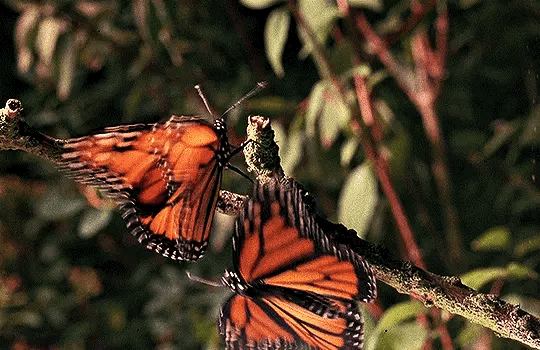
Children's Books:
Heidi - Johanna Spyri
Grimm's Complete Fairy Tales - Jacob and Wilhelm Grimm
Bezzus and Ramona - Beverly Cleary
How To Eat Fried Worms - Thomas Rockwell
Henry Higgins - Beverly Cleary
Charlotte's Web - E.B. White
Esperanza Rising - Pam Munoz
Animal Farm - George Orwell
Aesop's Fables - Aesop
The Complete Fairy Tales - Hans Christian Andersen
Dinotopia - James Gurney
The Wishful Princess - Kathie Kalafatis
The Complete Short Stories Of Mark Twain - Mark Twain
The Adventures Of Tom Sawyer - Mark Twain
Pagan Papers - Kenneth Grahame
Adventures Of Huckleberry Finn - Mark Twain
Hometown - Norman Rockwell
The Wind In The Willows - Kenneth Grahame
The Legend Of Sleep Hollow - Washington Irving
Dave Dashaway The Young Aviator - Roy Rockwood
The Outsiders - S.E. Hinton
Campfire Girls Collection - Halcyon Classics
Pippi Longstocking - Astrid Lindgren
The Children Of Green Knowe (Collection) - Lucy M. Boston
Anglo-Saxon Boy - Tony Brandman
Perrault's Fairy Tales - Charles Perrault

Adult Literature:
The Twelve Ceasars - Suetonius
The Prairie Trilogy - Willa Cather
The Complete Fiction of H.P. Lovecraft - H.P. Lovecraft
The Canterville Ghost - Oscar Wilde
SPQR: A History of Ancient Rome - Mary Beard
Major Works of Charles Dickens - Charles Dickens
True Grit - Charles Portis
King Arthur and His Knights - Howard Pyle
The Complete Sherlock Holmes - Conan Doyle
The Picture of Dorian Gray - Oscar Wilde
Ivanhoe - Walter Scott
The Iliad and the Odyssey - Homer
The Art of War - Sun Tzu
Madame Bovary - Gustav Flaubert
Angels and Insects - A.S. Byatt
My Confession - Leo Tolstoy
The Complete Bronte Collection - Bronte Sisters
Valperga- Mary Shelley
For Whom the Bell Tolls - Earnest Hemingway
Uncovering Celtic Mythology - Lucas Russo
The Way of the Wyrd: Tales of An Anglo-Saxon Sorcerer - Brian Bates
The Castle of Otrano: A Gothic Story - Horace Walpole
Lord of the Flies - William Golding
The Complete Tales of Edgar Allan Poe - E.A. Poe
The Complete works of Jane Austen- Jane Austen
The Alchemist- Paulo Coelho
The Orphan on the Rhine - Eleanor Sleath
The Strange Case of Dr. Jekyll and Mr. Hyde - Louis Stevenson
The Last Kingdom - Bernard Cornwall
Toll the Hounds - Steven Erikson
The Midnight Bell - Francis Lathom
Dracula - Bram Stoker
The Woman in Black - Susan Hill
The Divine Comedy: Inferno - Purgatorio - Paradiso - Dante Alighieri
Saxons, Vikings and Celts - Bryan Sykes
The Life and Opinions of Tristram Shandy, Gentleman - Laurence Sterne
Gone With The Wind - Margaret Mitchell
The White Horse King: The Life of Alfred Great - Benjamin R. Merkle
Moll Flanders - Daniel Defoe
The Last of The Mohicans - James Fenimore Cooper
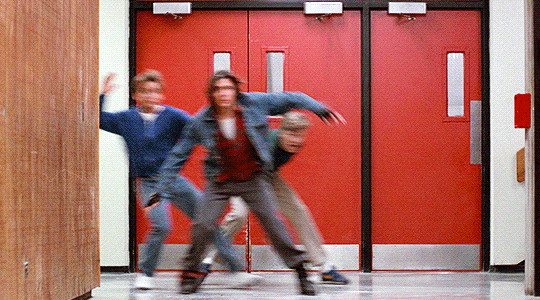
Movies/Film:
Salaam Bombay (1988)
The Assassination of Jesse James (2007)
Creepshow (1982)
The Wolf if Wallstreet (2013)
Gangs of New York (2002)
Stand by Me (1986)
The Outsiders (1983)
Shaun of the Dead (2004)
The Lost Boys (1987)
Interview with the Vampire (1994)
Scarface (1983)
Whatever Happened to Baby Jane (1962)
Bandit Queen (1995)
Gentlemen Prefer Blondes (1853)
Dances With Wolves (1990)
Gone With The Wind (1939)
The Return of the Living Dead (1985)
The Godfather (1972)
Titanic (1997)
Hellraiser (1987)
The Terminator (1984)
The Exorcist (1973)
Last of the Mohicans (1992)
Goodfellas (1990)
The Omen (1976)
Psycho (1960)
Bully (2001)
Bonus:
My Lovely Sam Soon - KDrama (2005)😂😭🤣
23 notes
·
View notes
Text
Ode a Thierry Mugler, scultore di femminilità

In questa foto, giovane e dal piglio fetish, posava per l'amico Helmut Newton, autore delle più celebri foto che ritraggono le sue creazioni. Manfred Thierry Mugler era un uomo che aveva ben chiaro il suo ideale di femminilità e si è impegnato anima e corpo a donarlo al mondo.
La sua idea di donna era un'esasperata silhouette di clessidra, coadiuvata da corsetti estremi. Una femminilità sempre sfrontata ed esibita al mondo, pur non risultando mai volgare.
Nelle sue mani le donne diventavano libellule e farfalle, insetti antropomorfi (come nella collezione "Les Insectes" del 1997), moto dal rombo potente, automi alla Metropolis, ninfe immortali.
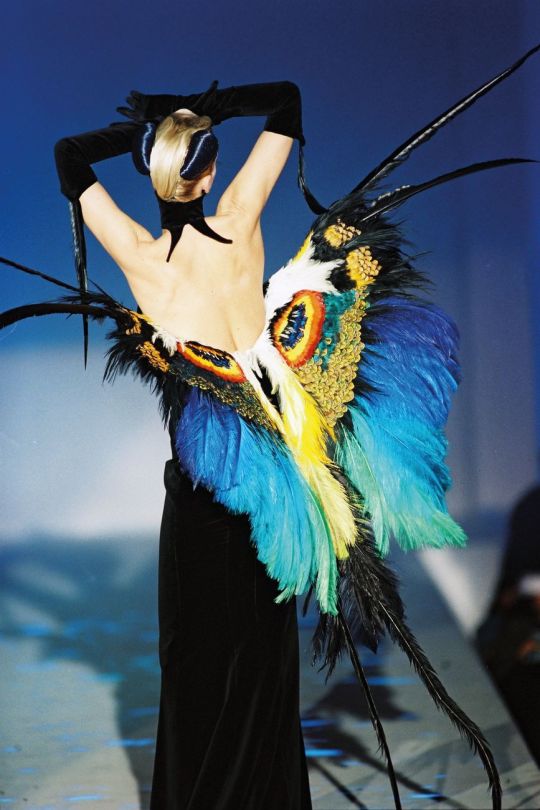
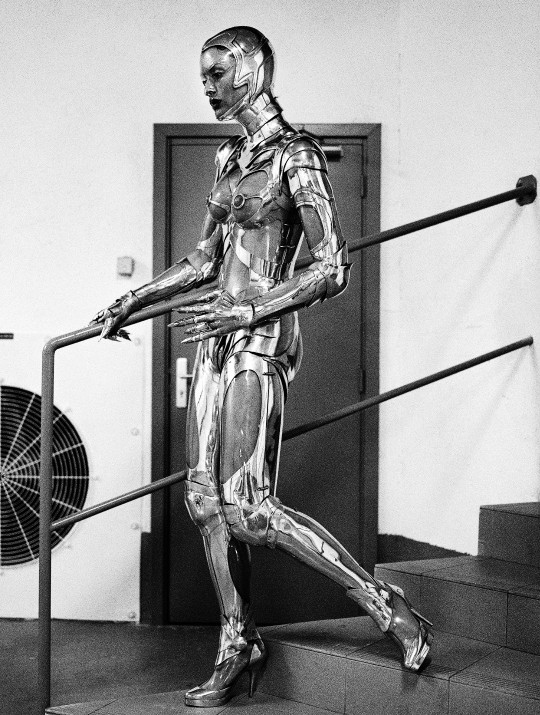
Le sue modelle non erano semplici indossatrici ma autentiche performer dei suoi show: non manichini ma donne piene di personalità, mai viste simili sulle passerelle, vive, birichine, che sapevano come prendersi il palco e gli applausi. Vere dive.
Non modelle ma muse, il cui rapporto con il couturier è durato nel tempo: Jerry Hall, Simonetta Gianfelici, in tempi più recenti Irina Shayk.
E' stato uomo di spettacolo anche nelle collaborazioni, fra cui una con il Cirque Du Soleil.

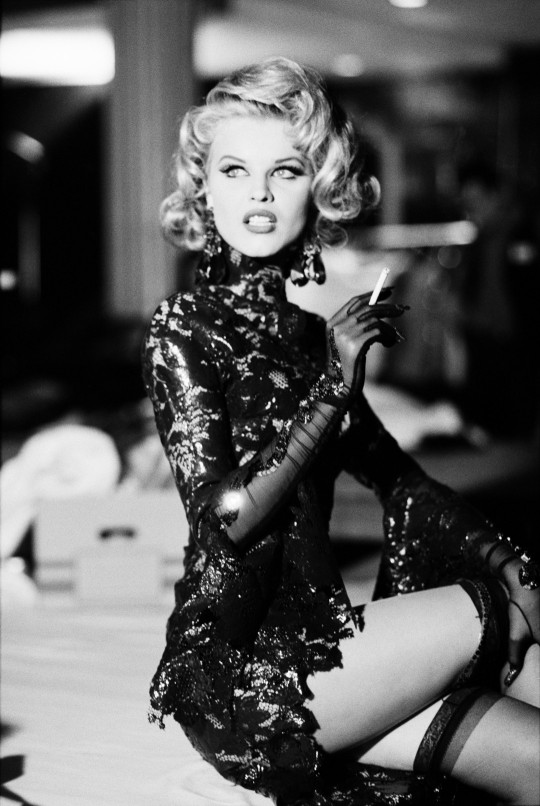
Pur amando la bellezza, puntava molto sulla personalità e sulla grande presenza scenica: oltre alle supermodel più celebri del periodo, portava in scena bellezze agée (Carmen Dell'Orefice fra le altre) e donne dall'aspetto non convenzionale (Rossy De Palma sfilò per lui nel '95). Fu il primo stilista a portare in passerella una cantante: si trattò di Diana Ross, nel 1995.
Negli ultimi anni il suo successore Nicola Formichetti è rimasto fedele al suo esempio, scegliendo come musa della maison Lady Gaga.

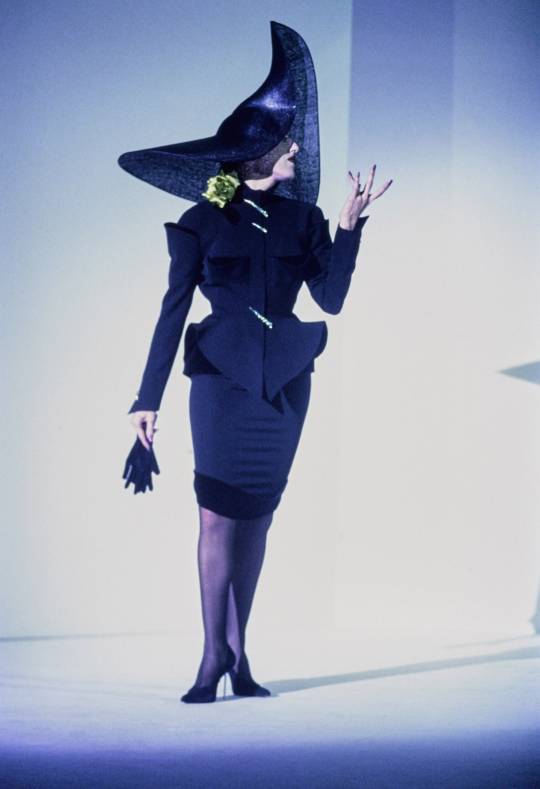
Molti sono stati i suoi autori di riferimento nel cinema e nella fotografia. In una recente intervista (link) livello cinematografico citò, fra i registi che lo avevano maggiormente ispirato, Carl Theodor Dreyer, Josef von Sternberg, Fritz Lang, Billy Wilder, Federico Fellini e Luchino Visconti; fra i fotografi figuravano Cecil Beaton, George Hoyningen-Huene e Horst P. Horst (come non pensare al suo Mainbocher Corset?). Molte delle sue muse evocano in modo potente Marlene Dietrich e la sua aurea di donna divina e imperscrutabile che sa quello che vuole e sa come andare a prenderselo.
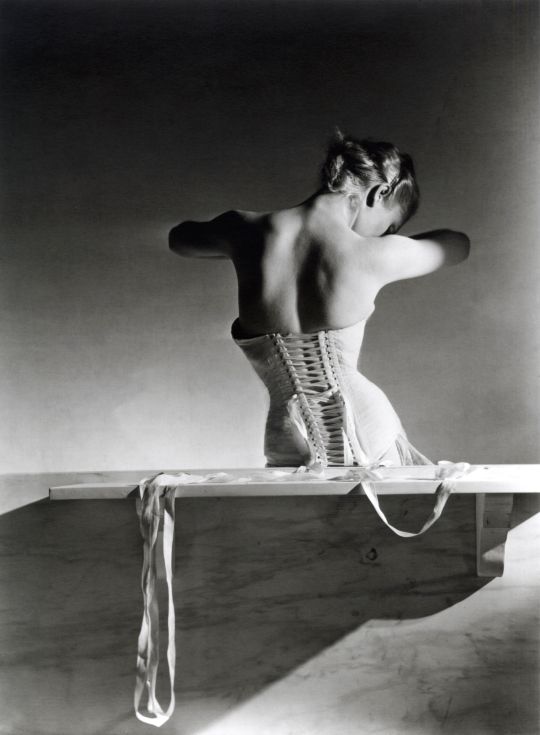
E forse anche il Blaue Engel di Von Sternberg ha ispirato a Mugler la creazione del profumo Angel (1992), noto per essere stata la prima fragranza "gourmand" della storia, seguita anni dopo dall'iconico Alien (2005), la cui pubblicità rappresenta la donna come creatura irraggiungibile ed extraterrestre. Giusto qualche anno dopo che un'immagine simile era stata proposta al pubblico da J'Adore di Dior (creato nel 1999, ndr).


Dopo una vita dedicata a esaltare le donne nel loro essere opere d'arte in movimento, ieri Mugler è morto, troppo presto (73enne).
Degli stilisti contemporanei è forse stato quello che più ha pensato le donne in tutti i modi possibili, tranne che come soggetti passivi, bamboline inerti. Nella vita come nella moda.
PER CONOSCERLO MEGLIO
LIBRI:
Thierry Mugler, Couturissime, PHAIDON / L'ippocampo edizioni
MOSTRE:
Thierry Mugler: Couturissime, Musée des Arts Décoratifs di Parigi (fino al 24 aprile 2022).
#thierry mugler#necrologio#helmut newton#alien#angel numbers#haute couture#jerry hall#corsetto#nicola formichetti#lady gaga#diana ross
19 notes
·
View notes
Text
What went down on this date in music…
February 25th
1956 - Elvis Presley
Elvis Presley had his first national hit when 'I Forgot To Remember To Forget' went to No.1 on the Billboard Country & Western chart. The Beatles covered this song once for the BBC radio show, From Us To You, on 1 May 1964, with George Harrison on lead vocals.
1957 - Buddy Holly
Buddy Holly recorded a new version of 'That'll Be The Day', at Norman Petty Recording Studio in Clovis, New Mexico. The title being taken from a phrase used by John Wayne in the film 'The Searchers.'
1972 - Paul McCartney
Written after the 'Bloody Sunday Massacre', in Northern Ireland Paul McCartney and Wings released 'Give Ireland Back To The Irish.' The song was banned by the BBC and the IBA. It peaked at No.16 in the UK and No.21 in the US.
1972 - Led Zeppelin
Led Zeppelin appeared in front of over 25,000 fans at the Western Springs Stadium, Auckland, New Zealand, the group's first ever gig in New Zealand, (and the largest crowd ever to attend a concert on the island). A special train was chartered from Wellington to bring fans to the concert. News reviews the next day reported the band could be heard over five miles from the Stadium.
1984 - Van Halen
'Jump', by Van Halen started a five-week run at No.1 on the US singles chart, (a No.7 hit in the UK). Singer David Lee Roth wrote the lyrics after seeing a television news report about a man who was threatening to commit suicide by jumping off a high building. Roth thought that one of the onlookers of such a scene would probably shout "go ahead and jump".
1995 - Frank Sinatra
At a private party for 1,200 select guests on the closing night of the Frank Sinatra Desert Classic golf tournament, Frank Sinatra sang before a live audience for the very last time. His closing song was 'The Best is Yet to Come'.
2004 - Bruce Springsteen
The Rolling Stones topped a US Rich List of music's biggest money makers. The list was based on earnings during 2003 when the band played their 'Forty Licks' tour, which made them $212 million, (£124.7m) in ticket, CD, DVD and merchandise sales. The three million fans who went to the shows spent an average of $11 (£6.47) each on merchandise. Bruce Springsteen was listed in second place and the Eagles in third.
2009 - Stevie Wonder
President Obama honoured Stevie Wonder his musical hero, with America's highest award for pop music, the Library of Congress' Gershwin prize at a ceremony at the White House. The president said the Motown legend had been the soundtrack to his youth and he doubted that his wife would have married him if he hadn't been a fan. Wonder's song 'Signed, Sealed, Delivered' had been the theme song during Obama's presidential campaign.
2011 - Susan 'Suze' Rotolo
Susan 'Suze' Rotolo, died from lung cancer. She was the one time girlfriend of Bob Dylan, and the inspiration of some of his early songs. Susan appeared in one of the decade's signature images, walking with Dylan arm-in-arm for the cover photo of his breakthrough album Freewheelin Bob Dylan.
2015 - George Harrison
On what would have been George Harrison's 72nd birthday, a new tree was planted in his memory in Griffith Park Los Angeles to replace one that was earlier killed by a beetle infestation. This new yew tree had been chosen to replace the original, as it was far less susceptible to insects.
4 notes
·
View notes
Text
Third Phase of Damien Hirst’s Yearlong Gagosian Takeover Opens Today in London
October 5, 2021
Third Phase of Damien Hirst’s Yearlong Gagosian Takeover to Feature Emergency Paintings, Danger Paintings, Hazard Pictures and Seizures Opening in London on October 5, 2021

It’s about violence and danger and escapism and death and warning signs and being safe or getting caught. —Damien Hirst LONDON, October 5, 2021—Gagosian is pleased to present Emergency Paintings, Danger Paintings, Hazard Pictures and Seizures, the third phase of Damien Hirst’s yearlong takeover of the Britannia Street gallery. The exhibition features paintings, photographs, and sculptures that address the experience and emotions of warning, danger, crime, rescue, and death. The works take their inspiration from a variety of sources, including the bold designs on emergency vehicles, the skins of dangerous animals, and media images of police activity. The exhibition follows the inaugural installment in the takeover sequence, Fact Paintings and Fact Sculptures, and the second, Relics and Fly Paintings. The Emergency Paintings series (2014–16) was born from long car journeys during which Hirst was struck by the graphics emblazoned on emergency vehicles and their use of color as a warning. He took photos of these disturbing and beautiful designs with his phone and incorporated their high-visibility stripes and chevrons into his paintings. Powerfully conveying a sense of real-world crisis, these works also evoke the hard-edge abstractions of such painters as Ellsworth Kelly, Kenneth Noland, and Frank Stella. Featured alongside the paintings is a framed selection of Hirst’s original source photos, which the artist values for their raw documentary quality: “They aren’t careful or considered. . . . They are quick and easy snaps taken as the world was flying by,” he remarks, “and all the better for it.”
Also on view at Britannia Street are several smaller oil-on-canvas compositions from the related series Danger Paintings (2016). These show close-up views of the skin of dangerous animals including poisonous frogs, snakes, insects, and sea creatures—living things that employ color and pattern to signal their danger to potential predators. As Hirst notes, this coloration represents “a thing that nature does that’s similar to what we do on emergency vehicles. We stole the idea from nature, of course, and hid it in geometry.” Finally, the exhibition includes several sculptures based on media photographs of police drug seizures, in which large quantities of illegal substances are displayed to promote the authorities’ success. The Seizures series (2021) represents a continuation of Hirst’s long-standing fascination with drugs and medicine—which has also resulted in such iconic series as Instrument Cabinets, Medicine Cabinets, and Pill Cabinets—and reflects his interest in and use of systems of taxonomy and display. Damien Hirst was born in in Bristol, England, and lives and works in London and Devon, England. Collections include the Museo d’Arte Contemporanea Donnaregina, Naples, Italy; Museum Brandhorst, Munich; Museum für Moderne Kunst, Frankfurt am Main, Germany; Stedelijk Museum, Amsterdam; Centro de Arte Dos de Mayo, Madrid; Tate, London; Israel Museum, Jerusalem; Astrup Fearnley Museet, Oslo; Gallery of Modern Art, Glasgow, Scotland; National Centre for Contemporary Arts, Moscow; Museum of Modern Art, New York; Hirshhorn Museum and Sculpture Garden, Washington, DC; Art Institute of Chicago; The Broad, Los Angeles; Museo Jumex, Mexico City; and 21st Century Museum of Contemporary Art, Kanazawa, Japan. Exhibitions include Cornucopia, Oceanographic Museum of Monaco (2010); Tate Modern, London (2012); Relics, Qatar Museums Authority, Al Riwaq (2013); Signification (Hope, Immortality and Death in Paris, Now and Then), Deyrolle, Paris (2014); Astrup Fearnley Museet, Oslo (2015); The Last Supper, National Gallery of Art, Washington, DC (2016); Treasures from the Wreck of the Unbelievable, Palazzo Grassi and Punta della Dogana, Venice (2017); Damien Hirst at Houghton Hall: Colour Space Paintings and Outdoor Sculptures, Houghton Hall, Norfolk, England (2019); and Mental Escapology, St. Moritz, Switzerland (2021). Hirst received the Turner Prize in 1995. __________ DAMIEN HIRST Emergency Paintings, Danger Paintings, Hazard Pictures and Seizures Open from October 5, 2021 6–24 Britannia Street, London _____ Damien Hirst, Safety, 2015, acrylic and acrylic lacquer on canvas, 94 × 84 inches (243.8 × 213.4 cm) © Damien Hirst and Science Ltd. All rights reserved, DACS 2021
8 notes
·
View notes


